#Mangrove: Carcinoscorpius Rotundicauda
Explore tagged Tumblr posts
Text
Fish of the Day
Today's fish of the day is the mangrove horseshoe crab!
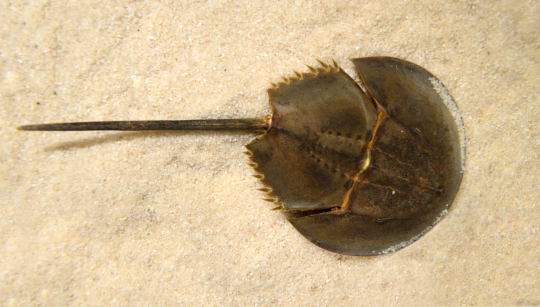
The mangrove horseshoe crab, also known as the round-tailed horseshoe crab, and scientific name Carcinoscorpius rotundicauda is one of the four living species of horseshoe crab remaining. The mangrove Horseshoe crab is closely related to the other 2 Asian horseshoe crabs: The Indo-Pacific Horseshoe crab (Tachypleus gigas), and the Chinese Horseshoe crab (Tachypleus tridentatus), but is the only member of the Carcinoscorpius genus. These three horseshoe crabs are separate from the American Atlantic Horseshoe crab, which separated between 130 to 400 million years ago! Now, Horseshoe crabs are horribly named, as they're not crabs at all. Instead, they belong to subphylum Chelicerata, which is in the Arthropod phylum, directly relating them to spiders and ticks.
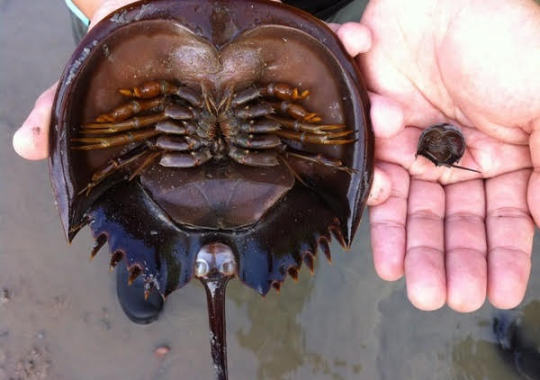
Like its name implies, the mangrove horseshoe crab lives in brackish waters in mangrove forests. They can be found across Southeastern Asia, down to the Indo-Pacific in Tropical and subtropical climates. This animal spends its time in shallow waters, preferring sandy areas. The mangrove Horseshoe is benthopelagic, meaning it lives its life on the seafloor, and although they rarely do so, horseshoe crabs can swim, albeit, upside down. I'd recommend looking up a video on them swimming, it's very cool to see!

As benthic creatures, the mangrove horseshoe crabs diet is limited to what it can find on the seabed. Not only that, but, like all parts of the Chelicerata subphylum, it lacks jaws and teeth, and so it must feed in another method. Horseshoe crabs eat by grabbing prey with chelicerae, a pair of appendages in front of its legs, and passing prey to a food grove that runs from the furthest back legs, and up to the mouth. Well in the food grove, the bases of the legs are used to grind prey with teeth like structures, simultaneously passing further forward. Due to horseshoe crabs being so unchanged over the years, it is thought that this feeding method may have belonged to some of the earliest Arthropods. The diet of the mangrove horseshoe crab in particular is made up of insect larvae, small fish, marine worms, and mollusks. Although mangrove horseshoe crabs in particular have a strong preference for insect larvae above other prey.
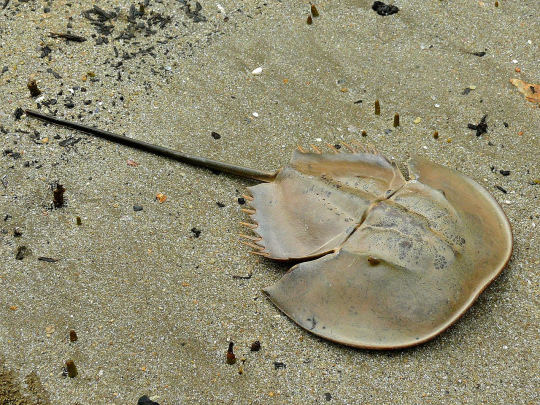
Anatomically horseshoe crabs get stranger yet. They contain 10 eyes: 2 compound eyes, which can be seen on the top of the head, used primarily for finding mates. Then, there is a pair of lateral eyes, on the underside, ventral eyes, used for finding prey, an endoparetial eye, and median eyes. Horseshoe crabs can see both visible and ultraviolet light, but are particularly sensitive to light amounts and changes in their surroundings. The tail, as opposed to some common thought, is not poisonous or a weapon, but rather it is used for flipping over easily, and some movement well swimming. In Mangrove horseshoe crabs the tail is far more rounded than its relatives.
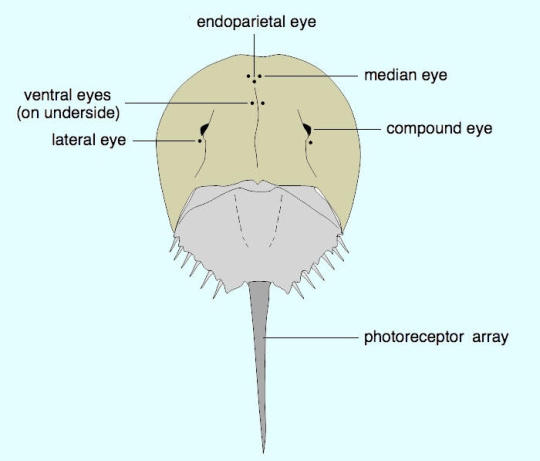
Have a good day everyone!
#fish of the day#mangrove horseshoe crab#horseshoe crab#carcinoscorpius rotundicauda#fish#fishblr#crab#arthropod
22 notes
·
View notes
Text
Vulnerable Crabs

A mating pair of Mangrove Horseshoe Crabs in the River Wonders. Photo credit: Jonathan Chua.
This Mangrove Horseshoe Crab is apparently listed as “vulnerable” in the Singapore Red Data Book.
The exposure was biased 1-1/3 stops darker to keep highlights. In post, the image was then exposed to the right, highlights of the sand were pulled back drastically to exaggerate textures while shadows of the crabs were lifted up to reveal more details.
#photographers on tumblr#arthropod photos#canon eos 50d#canon photography#Carcinoscorpius rotundicauda#flora fauna#mangrove horseshoe crab#photography editing#photography tips#tamron 18-270mm LD#tropical marine life#wildlife photography
6 notes
·
View notes
Text

Flat Fuck Friday!
(Mangrove horseshoe crab - Carcinoscorpius rotundicauda)
6 notes
·
View notes
Text
The mangrove horseshoe crab, Carcinoscorpius rotundicauda, is indigenous to the coasts of South and Southeast Asia. An alternative common name of round tailed horseshoe crab relates to its tail spine being more rounded rather than triangular in transverse proportions, as it is in Limulus and Tachypleus This is also the smallest species of horseshoe crab, and as in the other genera, the females average larger than the males.
Just more than half of the total length of C. rotundicauda is the tail, and the width across the animal is also a bit more than half its total length. Large females reportedly grow to 40 centimeters long, although this is very large. Typically the females grow to 30 to 32 centimeters, or 12 to 12 and a half inches long. Being smaller than the females, the males average 28 to 30 centimeters or 11 to 12 inches long.
There are four known species of horseshoe crab or limulid extant today, and the Atlantic genus Limulus itself, known as the king crab, is the basalmost member of the crown clade. Carcinoscorpius is regarded as a separate genus from the remaining two species, which comprise a separate Asian genus, Tachypleus, of which two extant species are recognized. The natural range of Carcinoscorpius overlaps with those of both Tachypleus species, and members of both genera can be present in the same shipments of Asian horseshoe crabs, that are destined for aquarium retail. This is because the 'crabs' are collected whilst small, in locations close to river mouths.
Per the assignment of fossils to genera, both Limulus and Tachypleus have fossil records as early as the Cretaceous period. Outwardly, horseshoe crabs as a clade have remained much the same since their Palaeozoic dawn, with their general form snd function first appearing millions of years before the first mammals and dinosaurs walked the earth. There is more ecological and anatomical variation among the stem limulids, that non-specialist accounts downplay when treating this clade in passing. Natural selection over a deep geological timescale, has largely stabilized their morphology throughout the passage of time, so that the modern forms still closely resemble the ancient stem limulids.
As is well known, the limulid total group, called the xiphosurans, are related to the arachnids, and together they comprise a mighty clade named the prosomapods. True crabs are members of the mandibulates, and they are more closely related to insects, barnacles, and centipedes. Within the prosomapod clade, the sometimes spectacular Palaeozoic eurypterids are more closely related to the mainly terrestrial arachnids, than to the horseshoe crabs. Fossil trackway evidence suggests that prosomapods were even foraging ashore as early as the Cambrian period. Some of the eurypterids were not marine, and some of them were even terrestrial carnivores.
Although true scorpions are arachnids, and arachnids are not eurypterids, the eurypterids are often called 'sea scorpions'. Complicating the matter further is that authentic stem scorpions are inferred to have been at least semi-aquatic, suggesting that the arachnids themselves might have started off in the water. Over evolutionary time the book gills seen in horseshoe crabs, that breathe in water, developed into the internalized book lungs of some strictly air breathing arachnids, before eventually, the evolution of a more efficient tracheal complex and the associated loss of the book lungs in more derived arachnids.
All of the four species of horseshoe crab are fairly euryhaline. Particularly there is natural selection for good environmental tolerance on the larvae of all four species, because of where the adults deposit their eggs. This can be in the intertidal zone of a beach, in a tidal salt marsh, or beside a mangrove creek, depending on the species. C. rotundicauda is currently the least marine species, but stem limulids have repeatedly colonised freshwater environments through geological time. This includes two major but extinct radiations of stem limulids, the bellinurines and the austrolimulids, in non-marine environments.
Also in some Carboniferous fossil environments, in which terrestrial and aquatic assemblages can be distinguished, some stem limulids are associated with fossils of myriapods and arachnids. Likely some stem limulids were at least semi-terrestrial in the distant, geological past. Today all of the horseshoe crabs are unusual among marine and estuarine animals, for returning ashore to deposit their eggs. This doesn't prove their ancestors returned to the sea, because some fishes have evolved the same behavior.
C. rotundicauda are recorded in waters with a salinity value of 1 to 28 ppt and a pH of 6.3 to 7.6. but according to sampling data from Malaysia, they are most common where the salinity is over 10 and below 30 ppt, and the pH 6.7 to 7.5. The temperature year round, according to the samples taken, is 27 to 31 degrees centigrade The larvae of C. rotundicauda are not strongly stressed by any brackish salinity, but they do show slightly more optimized functioning when they are housed at 20 ppt. This contrasts with the optimal salinity of 25-30 ppt for larvae of the sympatric Tachypleus gigas, which does not stay in mangrove habitats all its life, but does lay its eggs in brackish environments upstream.
Unlike sympatric Tachypleus, the juveniles of which are also found in the same estuaries, the sub-adult C. rotundicauda do not migrate downriver and out to sea, instead remaining strongly associated with the low salinity environments of their birth. Whereas adult T. gigas are associated with substrates of sand, C. rotundicauda live and feed upon silt-clay beds. Where the two species are sympatric at a locality, C. rotundicauda will be more frequent in months of low salinity, during which time the frequency of T. gigas will be low, according to the overlapping tolerances but differing preferences of these two species.
Like other horseshoe crabs, Carcinoscorpius is best considered an indiscriminate benthic forager, not an active predator, and it does not consume large, dangerously struggling prey. It's primary diet is composed of annelids and molluscs, both thin-shelled bivalves and gastropods, amid smaller proportions of other items such as small crabs. The species consumes fish eggs and juveniles, and opportunistically consumes fish carrion. All the extant horseshoe crabs are dietary generalists
In the aquarium, horseshoe crabs are unfussy feeders, that not only accept feedings of fresh and defrosted seafood items, but also sinking pellets as are manufactured as food for fish. They are quite benign towards ornamental corals, and to all but tiny fish, but these large and active animals do require a large, unobstructed area of soft substrate on which they will roam. The rigidity of their bodies means they they require turning as well as walking space. For this reason the area of open substrate they can access, should be at least five by three times the total length of the largest horseshoe crab.
Horseshoe crabs also love to dig, so this substrate must also be soft and deep enough to satiate their natural instincts. All horseshoe crab species will live on fine sand and mud bottoms in the aquarium. The extensive, complicated aquascapes of simulated reef environments would impede their activities. Worse than that, accidents in public aquaria have occurred when horseshoe crabs have become stuck in aquascapes. Although horseshoe crabs can use their sturdy tails to right themselves when they fall over, they have more difficulty getting themselves out if they get stuck.
In the aquarium environment, C. rotundicauda is most authentically housed in brackish parameters with a specific gravity of 1.01 to 1.02. a pH around neutral, and a temperature that is slightly warmer than is common in reef or freshwater aquariums. This preference and tolerance of heat is common among mangrove associated animals. This species adapts to ordinary reef tank temperatures and salinity, but they should not be accommodated permanently in freshwater aquariums.
Postlarval T. gigas that might arrive together with C. rotundicauda, are known to have overlapping but different environmental tolerances. This species is present at localities where water salinities are as low as 15 ppt, or specific gravity 1.01, but their life cycle requires a salinity of at least 20 ppt for development until hatching. This species grows to 50 centimeters long, or 20 inches.
The more temperate T. tridentatus from East Asia grows to almost 80 centimeters or 32 inches, and is the largest living horseshoe crab species. (Some Jurassic horseshoe crab tracks indicate an enormous, mysterious species.) This species functions optimally at 22-30 degrees centigrade, and juveniles grow better at 24-25 ppt. Another temperate species, Limulus polyphemus, is the best studied of the four but the published data can be contradictory. It grows to 60 centimeters or 24 inches long, which is smaller than records for Tachypleus, despite its name of 'king crab' implying it is the larger animal.
L. polyphemus are a temperate species that requires temperatures of at least 15 degrees centigrade for its growth before hatching, an environmental demand that sets a constraint upon its northern geographical spread. Wild L. polyphemus adults tolerate temperatures from -5 to 30 degrees centigrade, and this species supposedly fares best in aquaria at a lower temperature of 15 to 20 degrees, than is necessary for organisms from tropical coral reefs.
This species is mistraded sometimes as a tropical animal, and some professional aquarists have considered it cruel to house them at ordinary tropical tank temperatures. Fortunately, no distress is evident when subadult Limulus in public aquarium displays have been acclimatized to ambient temperatures in the lower 20s. L. polyphemus is a species found in marine environments, and adult L. polyphemus are more numerous where salinities measure closer to normal seawater than those where C. rotundicauda is commonest.
#Carcinoscorpius rotundicauda#mangrove horseshoe crab#round tailed horseshoe crab#horseshoe crabs#brackish#tachypleus#limulus
0 notes
Note
trick or treat !! I dont talk much here, but I think your v cool & funky and I always love seeing your funky things :DD
Thank you friend! I appreciate your kind words. :)
Tell you what. On May 8th, you sent me an ask about horseshoe crabs, and I wanted to make a little comic about them like I've done with Magnapinnas and some other sea friends. I did the research, I have the sources down, I even got to finishing all the sketches and some lineart! But, for some reason I lost motivation midway through, I just wasn't very happy with how my art looked in the comic so production slowly fizzled out. Here's an unfinished page with a distribution map for all the species of horseshoe crab! Done by hand by yours truly.
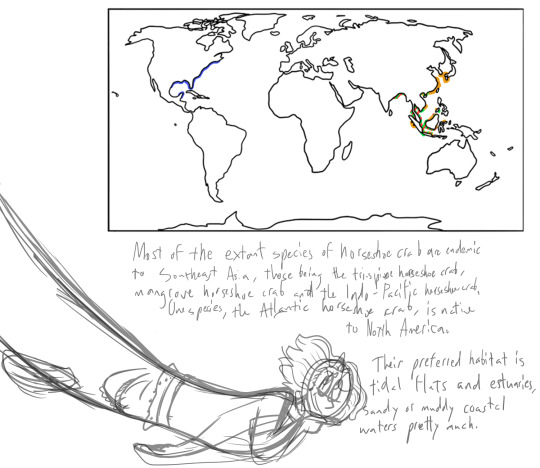
Blue is Atlantic horseshoe crab Limulus polyphemus, orange/yellow is trispine horseshoe crab Tachypleus tridentatus, green is mangrove horseshoe crab Carcinoscorpius rotundicauda, and red is coastal horseshoe crab (called Indo-Pacific horseshoe crab here) Tachypleus gigas. Hope this suffices as a treat!
12 notes
·
View notes
Note
Are there different types of horseshoe crabs?
There are!! there are four different species of horseshoe crab, the Atlantic Horseshoe Crab (Limulus polyphemus) which is found along the eastern coast of the United States & the Gulf of Mexico
the Mangrove Horseshoe Crab (Carcinoscorpius rotundicauda) & the Indo-Pacific Horseshoe Crab (Tachypleus gigas), which are both found in South & Southeast Asia
& The Tri-Spine Horseshoe Crab, sometimes also called the Chinese or Japanese Horseshoe Crab (Tachypleus Tridentatus), found in Southeast & East Asia!

Atlantic Horseshoe Crab blood contains a chemical called Limulus Amebocyte Lysate, or LAL. LAL reacts to harmful endotoxins, which causes the blood of Atlantic Horseshoe Crabs to clot up in order to protect the creature. For this reason, their blood is harvested for usage in the testing of vaccines, implants, & similar medical products. They are also the most studied species.
Indo-Pacific Horseshoe Crabs & Tri-Spine Horseshoe crabs also have a similar chemical in them, called Tachypleus Amebocyte Lysate, or TAL. It is used for much of the same usage in Asia. Recently, an artificial substitute, recombinant factor C, or rFC, has been created! If it is widely adopted, we may be able to stop or greatly lessen the amount of blood harvests, and save many horseshoe crabs. Indo-Pacific horseshoe crabs are generally larger then Atlantic ones.

The Mangrove Horseshoe Crab (pictured above), does not contain an amebocyte lysate like the other three species. Instead, their blood contains a deadly tetrodotoxin, a type of neurotoxin! Mangrove horseshoe crabs are also generally smaller than most other species.
7 notes
·
View notes
Photo


Daily Decay (27th September 2017): Cephalothorax of Horseshoe Crab (F. Limulidae) @ Pulau Ubin
Singapore is home to 2 species of Horseshoe Crab; both the Coastal Horseshoe Crab (Tachypleus gigas) and the Mangrove Horseshoe Crab (Carcinoscorpius rotundicauda) are found on Pulau Ubin.
1 note
·
View note
Photo

Did you know that Horseshoe crabs have blue blood? That they have existed virtually unchanged for 200.000.000 years?! Oh...and that they are my favorite animals! This is the mangrove horseshoe crab (Carcinoscorpius rotundicauda), one of 4 species that can be found these days! For more facts about horseshoe crabs, visit my youtube channel! https://youtu.be/fx7uqSJjNtI | Hi! My name is Hilmar, I'm a biology student and I LOVE ANIMALS! It is my passion to tell others about the cool creatures on earth in my YOUTUBE VIDEOS! So check out my channel 🎥 for more animals! 🐍🦈 | @de_wureld @uniwageningen @burgerszoo #nature #naturephotography #wildlife #wildlifephotography #animals #animal #biology #dieren #natuur #snake #herpetology #arachnids #spiders #cute #pets #science #invertebrates #invertebrate #invertebratesofinstagram #invertebratezoology #insect #insectsofinstagram #arthropod #horseshoecrab #bugs #bugsofinstagram | | TAG someone who needs to know this! SUBSCRIBE to BioVlogWild 🎥 | Youtube.com/Biovlogwild LINK IN BIO 🌍🌵🐘 (at Europe/Amsterdam) https://www.instagram.com/p/Bu_jtE_lLWn/?utm_source=ig_tumblr_share&igshid=11sk7mblwytvx
#nature#naturephotography#wildlife#wildlifephotography#animals#animal#biology#dieren#natuur#snake#herpetology#arachnids#spiders#cute#pets#science#invertebrates#invertebrate#invertebratesofinstagram#invertebratezoology#insect#insectsofinstagram#arthropod#horseshoecrab#bugs#bugsofinstagram
0 notes
Text
Ada Tiga Jenis Mimi di Indonesia; Adakah Cara Praktis Untuk Membedakanya ?
Tentu saja ada. Sebelumnya aku akan memberikan sedikit gambaran dulu kepada kalian, tentang pentingnya ketepatan identifikasi dengan menggunakan karakter morfologi. Perlu diketahui bahwa jenis mimi yang ada di Indonesia ada sebanyak tiga spesies, dan masing-masing jenisnya mempunyai ciri morfologi yang berbeda-beda. Oleh karenanya kita perlu tahu karakter apa saja yang dapat digunakan untuk mengidentifikasi ketiganya. Selain itu, basic data tentang mimi di Indonesia belum diungkap secara menyeluruh dan penelitiannya pun masih sedikit dibandingkan dengan negara tetangga, seperti Malaysia. Ketertinggalan ini dapat kejar dengan adanya upaya kerjasama antara para peneliti, akademisi dan masyarakat lokal khususnya nelayan. Kerjasama tersebut dimaksudkan untuk memperkaya basis data tentang ketiga jenis mimi yang ada. Adanya upaya tersebut tentu memerlukan panduan identifikasi yang tepat, mudah, dan praktis digunakan oleh siapapun.

Nah disini aku bakal memaparkan cara untuk identifikasi ketiga jenis mimi yang ada di Indonesia
Jenis pertama adalah Carcinoscorpius rotundicauda atau mangrove horseshoe crab. Sesuai namanya hewan ini dapat ditemukan di mangrove. Ciri utama dari mimi jenis C. rotundicauda ini adalah mempunyai bentuk ekor (telson) yang bulat dan halus. Ukuran mimi jenis ini juga lebih kecil dibandingkan dengn jenis lainnya.

(gambar ekor jenis Carcinoscorpius rotundicauda, bulat dan halus jika dipegang)
Jenis selanjutnya adalah berasal dari genus Tachypleus yang terdiri atas dua spesies yaitu Tachypleus tridentatus dan Tachypleus gigas. Jenis T. gigas ini biasanya dapat ditemukan di daerah perairan dangkal, dan beberapa juga ditemukan di daerah mangrove yang berpasir (saat melakukan pemijahan). Sedangkan untuk jenis mimi T. tridentatus mempunyai habitat di perairan dangkal dengan substrat berpasir juga akan tetapi lokasinya sedikit lebih jauh dibandingkan dengan T. gigas.

(ekor jika di pegang ada duri-durinya di bagian atas dan bentuknya segitiga ciri ekor T. tidentatus dan T. gigas)
Jenis T. tridentatus mempunyai ciri utama yaitu
Bentuk ekor yang segitiga dan terdapat duri-duri di bagian atas ekornya.
Jenis T. tridentatus ini mempunyai duri-duri halus yang tersebar di punggung opisthosoma.

(di punggung ada duri duri kecil tersebar ciri dari T. tridentatus)
Jenis T. gigas ini ciri utamanya mempunyai yaitu
Bentuk ekor segitiga dan terdapat duri-duri di bagian atas ekornya.
Punggung opisthosoma polos. Jenis ini tidak mempunyai duri-duri halus yang tersebar di punggungnya (pada bagian opisthosoma) atau polos.

(punggung polos tidak ada duri duri kecil tersebar ciri dari T. gigas)
0 notes
Photo

Daily Decay (1st September 2017): Mangrove Horseshoe Crab (Carcinoscorpius rotundicauda) @ Kranji
1 note
·
View note
Photo

Daily Decay (26th January 2017): Opisthosoma of Horseshoe Crab (F. Limulidae) @ Chek Jawa
Singapore is home to 2 species of Horseshoe Crab; both the Coastal Horseshoe Crab (Tachypleus gigas) and the Mangrove Horseshoe Crab (Carcinoscorpius rotundicauda) are found at Chek Jawa.
1 note
·
View note
Photo

Daily Decay (4th January 2017): Cephalothorax of Horseshoe Crab (F. Limulidae) @ Chek Jawa
Singapore is home to 2 species of Horseshoe Crab; both the Coastal Horseshoe Crab (Tachypleus gigas) and the Mangrove Horseshoe Crab (Carcinoscorpius rotundicauda) are found at Chek Jawa.
2 notes
·
View notes
Photo

Daily Decay (3rd February 2018): Moult of Mangrove Horseshoe Crab (Carcinoscorpius rotundicauda) @ Sungei Buloh Wetland Reserve
0 notes
Photo

Daily Decay (27th August 2017): Moult of Horseshoe Crab (F. Limulidae) @ Coney Island (Pulau Serangoon)
Singapore is home to 2 species of Horseshoe Crab; both the Coastal Horseshoe Crab (Tachypleus gigas) and the Mangrove Horseshoe Crab (Carcinoscorpius rotundicauda) are found at Coney Island.
0 notes
Photo


Daily Decay (9th August 2017): Opisthosoma of Horseshoe Crab (F. Limulidae) @ Chek Jawa
Singapore is home to 2 species of Horseshoe Crab; both the Coastal Horseshoe Crab (Tachypleus gigas) and the Mangrove Horseshoe Crab (Carcinoscorpius rotundicauda) are found at Chek Jawa.
0 notes
Photo

Cephalothorax of Horseshoe Crab (F. Limulidae) @ Coney Island (Pulau Serangoon)
Singapore is home to 2 species of Horseshoe Crab; both the Coastal Horseshoe Crab (Tachypleus gigas) and the Mangrove Horseshoe Crab (Carcinoscorpius rotundicauda) are found at Coney Island.
0 notes